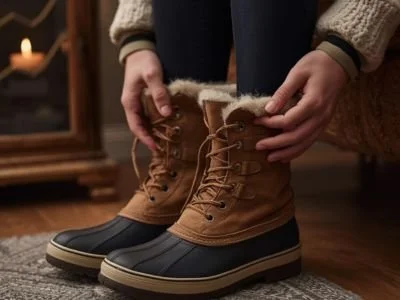Stepping Into Winter: How to Take Care of Your Feet as You Transition From Summer Shoes to Winter Boots by Anuta Bondarenko
As the weather cools and we trade sandals and lightweight sneakers for bulkier boots, our feet go through more of an adjustment than we often realize. This seasonal transition is the perfect time to check in on your foot health—especially if you’re dealing with aches, fatigue, or ongoing issues like plantar fasciitis, bunions, or arch pain.
Why Seasonal Transitions Matter
Summer footwear is typically more flexible, breathable, and minimal. Winter boots can be the opposite: structured, heavy, and insulated. Switching between the two styles changes how your foot moves, how your arches absorb load, and how your body distributes weight with each step.
This shift can trigger:
Increased pressure on the forefoot or heel
Tightness through the calves and Achilles
Increased pronation or supination depending on the boot design
New or worsening foot, knee, or lower-back pain
How to Choose a Winter Boot That Actually Supports Your Foot Needs
Not all winter boots are kind to your body. When shopping or switching over your footwear, keep these essentials in mind:
1. Prioritize Proper Fit
Your feet naturally swell throughout the day and change shape with temperature. A good winter boot should have:
A thumb’s width of space at the front
Room in the toe box (your toes should be able to wiggle freely)
A secure heel that doesn’t slip
Enough depth for a warm sock and potential orthotics
A poor fit leads to blisters, bruised toenails, nerve irritation, and cold toes due to restricted circulation.
2. Look for Arch and Ankle Support
Many stylish winter boots look great—but offer virtually no support. For long walks, commutes, or time on your feet, seek out:
A supportive footbed
A cushioned but stable midsole
A design that keeps your ankle aligned
If you rely on custom orthotics, ensure the boot has a removable insole so you can swap in your device easily.
3. Consider Weight and Flexibility
Heavy boots increase fatigue and can change how you walk. The ideal winter boot should be:
Lightweight enough not to alter your gait
Flexible at the ball of the foot
Sturdy enough to protect you from snow and ice
Preparing Your Feet for the Seasonal Shift
Stretch and Strengthen
Your feet and lower legs may need time to adapt to the change. Daily stretches and self massage — especially for the calves, rolling out the plantar fascia, and ankle circles — can prevent pain flares.
Useful moves:
Calf stretch over a rolled up towel
Bottom of the foot roll out with a ball
Ankle circles
Short-foot (intrinsic foot muscle) exercises
Wear toe spreaders or toe alignment socks (check out the ones we have available at the clinic) when at home and out of the boot
Check Your Socks
Winter socks should keep you warm without compressing your toes or altering the fit of your boots. Wool or moisture-wicking materials help prevent sweat build-up, which can cause blisters.
Signs Your Boots Aren’t Working for You
If you notice any of the following, it may be time for a new boot or a fit assessment:
Persistent foot or arch pain
Heel pain when you get out of bed
Tingling or numbness in the toes
Knee or hip discomfort that appears only after switching to boots
Slipping inside the boot or friction hotspots
How We Can Help
A proper footwear assessment isn’t just about comfort—it’s about preventing long-term biomechanical issues. At our clinic, we can evaluate and offer:
Foot mechanics and gait analysis
Arch type and loading patterns assessment
Taking a look at your current footwear
Orthotics and/or foot strengthening exercises that can support your transition into winter
Additional Resources:
Check out this wonderful foot and calf exercise video from our movement specialist Anuta below!
An excellent book on foot health
Simple Steps For Foot Pain Relief by Katy Bowman
A shoe store on the Danforth that offers foot health-friendly winter boots:
The Cool East Market https://cooleastmarket.com/

